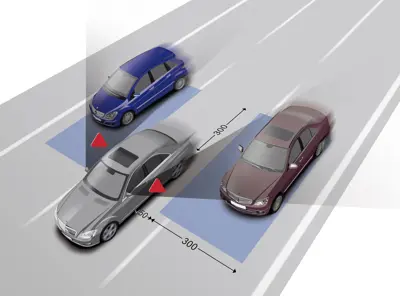- ADAS
- ACC
- ABS
- ALC
- AEB
- AES
- APA
- BSM
- CAS
- DDD
- DMS
- Efficiency Assist
- ESC
- Exit Warning
- FCW
- FCTA
- LCA
- LDW
- LKA
- RCTA
- TSR
Blind Spot Monitoring
Blind Spot Monitoring (BSM) is an advanced driver assistance system designed to help drivers detect and avoid collisions while changing lanes or merging into traffic.
Blind Spot Monitoring (BSM) systems use radar or cameras mounted on the side mirrors or rear bumper to monitor the area next to and behind the vehicle, commonly referred to as the blind spot. When the system detects a vehicle or object in the blind spot, it alerts the driver with visual or audible signals, such as a warning light on the side mirror or a sound inside the vehicle. Some systems may also provide additional alerts, like vibrating the steering wheel or seat.
Additional Features
Some BSM systems include features like Rear Cross Traffic Alert (RCTA), which alerts the driver if a vehicle or object is approaching from the side while reversing out of a parking space.
Safety Benefits
BSM systems enhance road safety by reducing the likelihood of collisions caused by driver error or misjudgment. However, they are not a substitute for attentive and safe driving practices. Drivers should always check their mirrors and look over their shoulder to ensure the lane is clear before changing lanes or merging into traffic.
Common Names for BSM Systems
Different manufacturers may use various names for their BSM systems, including:
- Blind Spot Detection (BSD)
- Blind Spot Information System (BLIS)
- Side Assist
- Lane Change Alert
- Lane Change Assist
- Lane Departure Warning System (LDWS) with Blind Spot Detection
While the names may vary, the function and purpose of these systems remain the same: to help drivers detect and avoid collisions while changing lanes or merging into traffic.

